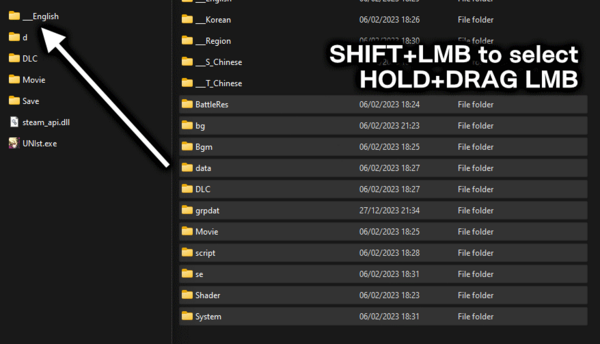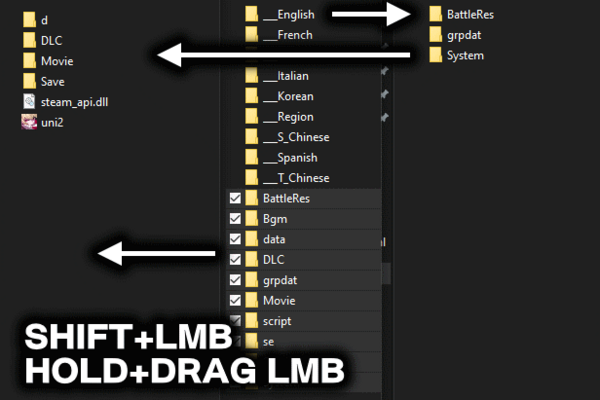|
|
| (3 intermediate revisions by the same user not shown) |
| Line 1: |
Line 1: |
| =Files= | | {{DISPLAYTITLE:Getting Started}} |
| Game files are located in the steamapps / common folder. This can be found by heading to your steam library, clicking properties on your game, then Installed Files > Browse…
| | {{PIXL BeginNav}} |
| This folder will be called the game directory for simplicity.
| | {{Disclaimer MFPG |
| | |border-color=#FF60B0 |
| | |bg-color= |
| | |image=MBTL_data_icon.png |
| | |text='''Huhuhu... This page is intended to explain how to setup a modding environment.'''<br/>Check out the [[User:Pixloen/sandbox#Guides_&_Tutorials|Guides & Tutorials]] section if you want to start making new mods! |
| | }} |
| | ==Getting the Game Files== |
| | The '''steamapps''' folder at the location of your game’s executable is where all mods are made. You can find it by going in your <code>Steam Library > Right clicking Under Night or Melty Blood > Properties > Local Files > Browse Local Files</code>. Once you've done that, we can start by unpacking the game files! |
|
| |
|
| In both games, the files are encrypted or compressed through different methods. It is recommended to have ample storage, as modding the game requires extracting all the assets.
| | === Setup Methods === |
| ==UNICLR== | | All the tools needed for mods can also be found at [[User:Pixloen/FPANModding/Links_and_Resources|Links & Resources]]. Different games require different methods. |
| Download the UNIST unpacker and extract the contents into the d folder. Use CTRL+A to select every file in the folder, unselect unistunpacker.exe. With that, drag every other file onto the exe to start the unpacking process. The unpacker is finished when it closes, and otherwise wait with patience. When done, you’ll notice that a folder called ‘output’ appears.
| | <tabber> |
| | |-|UNICLR= |
| | {{:User:Pixloen/FPANModding/UnpackCLR}} |
| | |-|UNI2= |
| | {{:User:Pixloen/FPANModding/UnpackUNI2}} |
| | |-|MBTL= |
| | {{:User:Pixloen/FPANModding/UnpackMBTL}} |
| | </tabber> |
| | ==What To Do Next== |
| | Well, congratulations on setting up your first mod! It's recommended to download the recommended tools at [[User:Pixloen/FPANModding/Links_and_Resources|Links & Resources]] and check out some of the [[User:Pixloen/sandbox#Guides_&_Tutorials|Guides & Tutorials]]. Modding a fighting game is a complex and sometimes time-consuming task, so make sure to take your time with it and figure out everything as you need to. If you want to jump straight into script editing and character creation, you ''could'' do that, but it may be easier to start with smaller mods and go up from there as it is easier to quickly build up an understanding of the French Bread engine. |
|
| |
|
| Mod environments are set up through language folders, which the game reads off of. Examples of valid folders include;
| | ===Ok, What's Something Simple?=== |
|
| |
|
| *___English | | *[[User:Pixloen/FPANModding/Audio|BGM & Audio]] mods and [[User:Pixloen/FPANModding/Palettes|palette]] mods are the easiest mod types to make. |
| *___Korean | | *Learn how to navigate [[User:Pixloen/FPANModding/Hantei-chan|Hantei-chan]] and figure out how to modify and add moves. |
| *___S_Chinese | | **Try messing around with character scripts to really make moves unique, and get an understanding of existing character's code. |
| *___T_Chinese | | ***Once you've done that you can start making your own character scripts and work your way to making new or modified characters! |
| | *Or try making some story mods by editing *[[User:Pixloen/FPANModding/Cutscenes|cutscenes]]. |
| | === What's Possible With Mods? === |
|
| |
|
| The game’s selected language determines which folder’s assets are read from. To create a mod environment, head to the output folder that was unpacked. Take notice of the language folders. Move one of them out to the game directory, and replace if prompted. Then, copy all non-language folders into the same folder. If you want to keep the original japanese assets, replace, otherwise skip if prompted.
| | A short summary of everything you can edit or create in the French Bread engine: |
|
| |
|
| And that’s it! All* files are available for editing. Inside your new language folder should be this structure:
| | # Create and edit characters, including custom scripts and names |
| | # Create and edit universal game mechanics through script edits |
| | # Create or edit universal knockback or pushblock (vectors) |
| | # Mod custom colors, music or sound effects |
| | # Edit the character or stage shaders for cool effects |
| | # Custom combo trials and tutorials |
| | # Edit UI through .pat editing |
|
| |
|
| [[File:PIXL_mainfolder.png]]
| | What can't be done |
|
| |
|
| ==Hardcoded Files and D File Editing==
| | # Importing 3D models to be used in stages |
| Some files are actually hard-coded so that they cannot be replaced or edited normally. The UNDER NIGHT IN-BIRTH engine uses encrypted assets found in the D folder and can force a hardcoded load (meaning your modifications may not work). Notable hardcoded assets include:
| | # Upscaling some .dds textures used in game (Cockpit, UI) |
| | |
| *Character Select Screen Visuals
| |
| *Character Names
| |
| *Dialogue and BattleRes
| |
| | |
| However, these hardcode limitations can be removed by editing the d files directly. Using HxD, find the file which contains the filename of the file you are trying to edit. This example will use csel01.pat, which contains the character select graphics (Note: there are two separate versions for if you do not have the Londrekia DLC installed.)
| |
| | |
| oMtaqooqotvvonnpwmq contains many of the files that are hardcoded.
| |
| | |
| [[File:PIXL_hex1.png]]
| |
| | |
| This filename listed here is all that needs to be changed. All that needs to be done is to make the filename different so that the game cannot find it in the mod directory. Here, I chose to change the number of the .pat file.
| |
| | |
| [[File:PIXL_hex2.png]]
| |
| | |
| And that’s it! The character select pat file can now be fully edited. This works with other formats too, such as text files and csv. files.
| |
| | |
| '''UNI2 NOTE''': If files have been D file edited, then those files MUST be in your game directory at all times. This is because of a change that prevents the game from loading the vanilla asset when it cannot detect a modded asset, causing crashes.
| |
| | |
| ==MBTL==
| |
| placeholder
| |
| https://imgur.com/a/5GQ2JDO
| |
| | |
| | |
| == Navigation ==
| |
|
| |
|
| | ==Navigation== |
| {{Navbox-MFPG}} | | {{Navbox-MFPG}} |
| [[Category:Modding French Bread Games]]
| |
For Beginners
Getting Started | File Structure | Installing Mods | Example Mods | Glossary | Links & Resources | Guides & Tutorials

|
Huhuhu... This page is intended to explain how to setup a modding environment.
Check out the Guides & Tutorials section if you want to start making new mods!
|
Getting the Game Files
The steamapps folder at the location of your game’s executable is where all mods are made. You can find it by going in your Steam Library > Right clicking Under Night or Melty Blood > Properties > Local Files > Browse Local Files. Once you've done that, we can start by unpacking the game files!
Setup Methods
All the tools needed for mods can also be found at Links & Resources. Different games require different methods.
Unpacking the game
Download the UNIST Unpacker, and place it inside the steamapps\common\UNDER NIGHT In-Birth Exe Late[st]\d folder. Then, press CTRL+A to select all the files within the d folder and unselect unistunpacker.exe Now with all the files selected, you can drag them Click and Hold LMB onto unistunpacker.exe. Once you've done that, a command prompt will open and the unpacker will unpack all the game files in UNICLR. This may take some time, so leave the command prompt in the background. Once it's finished the command prompt will close on it's own, and a new folder output will appear containing all the unpacked files.
Setting up a Language Folder

|
What's a Language Folder For?
Each in-game language loads it's own set of files from it's own folder, including non-localization files.
By using this property, we can have multiple mods on and change between them using the in-game language option.
|
First, go into the output folder and pick one of the languages. Copy that language folder into the game's root folder, which is where UNIst.exe is. This will be the basis for your mods. Once copied, go back into the output folder and select all NON-Language folders using SHIFT+LMB, and with the root folder in a seperate window, drag all the folders to the new language folder you've made. Alternatively you can also press CTRL+C to copy, then CTRL+V inside the new language folder. If you want to keep the localization files intact, when prompted DO NOT replace files, or re-copy the language files once more.
Changing or Disabling Mods
Once you've copied the game files over, you've successfully setup a language folder! This will be used as your modding environment. If you want to load in a different set of mods, or disable mods, you can do any of the following:
- Move the specific language folder out of the game root folder, such as into a separate "mod backup" folder.
- Rename the language folder so that the game doesn't recognize a language name. You can rename it back to restore the mods.
- Change the language using the in-game options menu. Depending on the mod, this may require a restart of the game for changes to fully take effect.
All of these actions make the game load in different mod files, or fallback files (which is just normal UNICLR). This is important if you want to continue playing netplay with those that do not have mods, for example.
How do I know that this is working?
We can setup a simple check mod to verify that we've setup everything correctly. Enter your language folder and navigate to System\str_jp\DLC.csv. Opening this file with Notepad or any other text editor should show the text Checking downloadable contents...,, which is the first text that appears when booting up the game. Simply replace this text with anything you want, making sure to keep the comma at the end. Once you've done that, simply open the game to check whether the text updated.
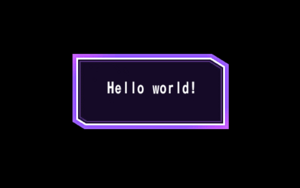
Hello world! We've made our first UNICLR mod!
Unpacking the game
Compile the UNIB Data Tool to use as an unpacker, and run the .exe using a command shell, providing both an input folder and output folder.
Alternatively you can download this compiled version, and extract both the .exe and the .bat files inside the steamapps\common\UNDER NIGHT IN-BIRTH II Sys Celes folder. Open up the batch file with a text editor like Notepad RMB > Edit, and you should see something like this.
@echo off
color a
uni2datatool "C:\SteamLibrary\steamapps\common\UNDER NIGHT IN-BIRTH II Sys Celes\d" "C:\SteamLibrary\steamapps\common\UNDER NIGHT IN-BIRTH II Sys Celes\d\Unpacked"
pause
Notice the two filepaths - the first one tells the unpacker where the d folder is, and the second tells the unpacker where to extract all the files. Simply update those addresses to match your game's and save. Then run the .bat file and wait for it to finish unpacking, which is when it waits for a key input. After, you'll see all the game files inside your output folder. The unpacking process may take a significant amount of time depending on the speed of your hard drive or SSD, so make sure to be patient otherwise you'll be missing many files.
Setting up a Modding Environment

|
Wait... Things are different!? This is hurting my brain...
Unlike in UNICLR, this game only loads files that are listed in internal directories. Read more to find out how modding works for this game!
|
First, go into the output folder and select all non-language folders. Then, press CTRL+C to copy and head back to the game root folder (where the UNI2.exe is), and CTRL+P to paste. What this does is match the unpacked files to the game's internal directory, allowing you to overwrite existing assets with your files, or add new ones. Once you're done, you can go into the output folder and select a language. Copy the contents of that language folder and paste them in the game root folder as well. When prompted, replace files. What this does is add back localization files, allowing you to keep, for example, English text.
How do I know that this is working?
We can setup a simple check mod to verify that we've setup everything correctly. Enter your language folder and navigate to System\str_jp\DLC.csv. Opening this file with Notepad or any other text editor should show the first line of text <GR_MS_CheckingForDLC>,, which calls the "Checking for add-on." text that appears when booting up the game. Simply replace this text (including the brackets) with a string, making sure to keep the comma at the end, example "Hello World, UNI2!",. Now that the mod has been made, next is actually making the game read the mod.
De-indexing D Files
If you haven't got it, download HxD. Open up file d/rcwWiiqjmxpmojs (and make sure to keep a backup somewhere safe), which corresponds to the System directory. What this (and a few other small files) contains is a file index which the game reads from. By changing the text of these filepaths, it's possible to de-index these files and force the game to search the directory for backup assets - the mods. Now simply search using CTRL+F for the file that we just changed, DLC.csv. Then change the name of the file, for example to DLC.csa. Now the d file is de-indexed and booting up the game should show our modified text.
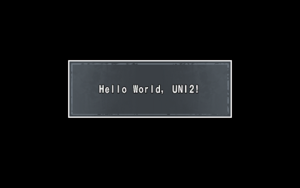
Hello world! We've made our first UNI2 mod!

|
This process has to be done for all modded files, but...
If you have the full game dump, you can instead de-index the entire folder of a d file by changing the filepath or folder name at the top.
|
Changing or Removing Mods
Unlike UNICLR, there are less ways to change or remove mods. The only viable method is to do the following:
- Keep a backup of the "vanilla" d folder, or go into Steam and verify files to remove mods
- Remove all modded files from the game and replace them with new mods to change them.
Unpacking the game
First, download the MBTL BIN Tool. Extract the zip and locate to the folder that contains MBTL.Unpacker.bat, MBTL.Unpacker.exe and the 0.10.2.0 folder. Copy and paste these items into the MBTL directory, which will be this in most cases C:\Program Files (x86)\Steam\steamapps\common\MELTY BLOOD TYPE LUMINA. Once you have done that, download the updated Cache files needed, and replace the ones that you placed in the MBTL directory earlier. Now, in order to unpack the game, right-click on MBTL.Unpacker.bat, Right Click -> Edit. Add the folder path of the MBTL Directory and the folder path of the unpacked files separated with "" respectively. (Example shown below)
Example → MBTL.Unpacker "C:\Program Files (x86)\Steam\steamapps\common\MELTY BLOOD TYPE LUMINA" "C:\Program Files (x86)\Steam\steamapps\common\MELTY BLOOD TYPE LUMINA\Unpacked_new"
If everything is done correctly up to this point, double click on the MBTL.Unpacker.bat file and watch your game start unpacking (This will take a few minutes to complete)

|
If you check files in Notepad and it comes up with random Chinese characters...
It means the cache is outdated. The current cache works for Update 1.45.
|
Making your first mod
Now it is time to get the DLL files needed in order for mods to load, as well as some extra files needed for Palette Color modding if needed. First, download FateUpdate.exe (courtesy of the MBTL Palette Gallery Discord server) and place this anywhere. Run the .EXE and a prompt should show asking where you want to extract the files. Use the tab to navigate to your MBTL directory mentioned above and click Extract.
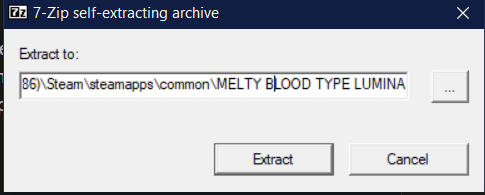
This is what the prompt should look like. Click the "..." button to select a directory.
To check if this worked successfully, we can make a test mod which changes the Singleplayer description at the bottom of the Main Menu. First, create a folder named str_jp in MBTL Directory → System. Then, get this file from your directory of Unpacked Files → ___English\System\str_jp\MainMenuCSText, and check that opening the file is in English characters. Copy and paste it in that new folder created earlier, then Right Click → Edit on the file. Change the text listed in "" to anything you want. After that save the file and run the game. Hover over to the Singleplayer section and check if the text is changed.

We've made our first MBTL mod!
Removing or Changing Mods
placeholder
What To Do Next
Well, congratulations on setting up your first mod! It's recommended to download the recommended tools at Links & Resources and check out some of the Guides & Tutorials. Modding a fighting game is a complex and sometimes time-consuming task, so make sure to take your time with it and figure out everything as you need to. If you want to jump straight into script editing and character creation, you could do that, but it may be easier to start with smaller mods and go up from there as it is easier to quickly build up an understanding of the French Bread engine.
Ok, What's Something Simple?
- BGM & Audio mods and palette mods are the easiest mod types to make.
- Learn how to navigate Hantei-chan and figure out how to modify and add moves.
- Try messing around with character scripts to really make moves unique, and get an understanding of existing character's code.
- Once you've done that you can start making your own character scripts and work your way to making new or modified characters!
- Or try making some story mods by editing *cutscenes.
What's Possible With Mods?
A short summary of everything you can edit or create in the French Bread engine:
- Create and edit characters, including custom scripts and names
- Create and edit universal game mechanics through script edits
- Create or edit universal knockback or pushblock (vectors)
- Mod custom colors, music or sound effects
- Edit the character or stage shaders for cool effects
- Custom combo trials and tutorials
- Edit UI through .pat editing
What can't be done
- Importing 3D models to be used in stages
- Upscaling some .dds textures used in game (Cockpit, UI)
Navigation
| For Beginners
|
|
| File Formats & Software Guide
|
|
| Engine Documentation
|
|
| Quick Start
|
|
| Guides
|
|
| Documentation
|
|
